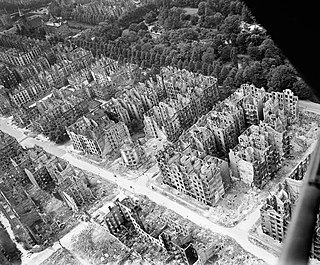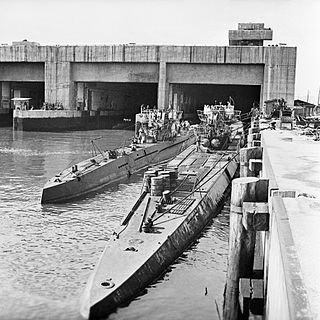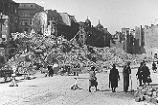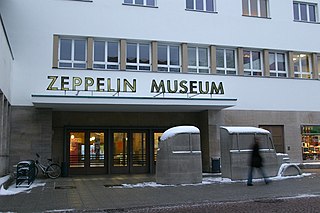
The Allied bombing of Hamburg during World War II included numerous attacks on civilians and civic infrastructure. As a large city and industrial centre, Hamburg's shipyards, U-boat pens, and the Hamburg-Harburg area oil refineries were attacked throughout the war.

Nordhausen is a city in Thuringia, Germany. It is the capital of the Nordhausen district and the urban centre of northern Thuringia and the southern Harz region; its population is 42,000. Nordhausen is located approximately 60 km north of Erfurt, 80 km west of Halle, 85 km south of Braunschweig and 60 km east of Göttingen.

Mittelbau-Dora was a Nazi concentration camp located near Nordhausen in Thuringia, Germany. It was established in late summer 1943 as a subcamp of Buchenwald concentration camp, supplying slave labour from many Eastern countries occupied by Germany, for extending the nearby tunnels in the Kohnstein and for manufacturing the V-2 rocket and the V-1 flying bomb. In the summer of 1944, Mittelbau became an independent concentration camp with numerous subcamps of its own. In 1945, most of the surviving inmates were sent on death marches or crammed in trains of box-cars by the SS. On 11 April 1945, US troops freed the remaining prisoners.

The Kassel World War II bombings were a set of Allied strategic bombing attacks which took place from February 1942 to March 1945. In a single deadliest raid on 22–23 October 1943, 150,000 inhabitants were bombed-out, at least 6,000 people died, the vast majority of the city center was destroyed, and the fire of the most severe air raid burned for seven days. The US First Army captured Kassel on 3 April 1945, where only 50,000 inhabitants remained, versus 236,000 in 1939.

The German city of Cologne was bombed in 262 separate air raids by the Allies during World War II, all by the Royal Air Force (RAF). A total of 34,711 long tons of bombs were dropped on the city by the RAF. 20,000 people died during the war in Cologne due to aerial bombardments.

A submarine pen is a type of submarine base that acts as a bunker to protect submarines from air attack.

Mittelwerk was a German World War II factory built underground in the Kohnstein to avoid Allied bombing. It used slave labor from the Mittelbau-Dora concentration camp to produce V-2 ballistic missiles, V-1 flying bombs, and other weapons.

The Bucharest World War II bombings were primarily Allied bombings of railroad targets and those of the Oil Campaign of World War II, but included a bombing by Nazi Germany after 1944 coup d'état. Bucharest stored and distributed much of Ploiești's refined oil products.

The city of Vienna in Austria was bombed 52 times during World War II, and 37,000 houses of the city were lost, 20% of the entire city. Only 41 civilian vehicles survived the raids, and more than 3,000 bomb craters were counted.

The Kohnstein is a hill in Thuringia, Germany, 2 kilometres southwest of the village of Niedersachswerfen and 3 kilometres northwest of the centre of the town of Nordhausen. Gypsum mining created tunnels in the hill that were later used as a fuel/chemical depot and for Nazi Germany factories, including the Mittelwerk V-2 rocket factory that used Mittelbau-Dora slave labour.

To carry out the planned V-1 "flying bomb" attacks on the United Kingdom, Germany built a number of military installations including launching sites and depots. Some of the installations were huge concrete fortifications.

The Bombing of Bremen in World War II by the British Royal Air Force (RAF) and US Eighth Air Force involved both indiscriminate "area bombing" and, as capacity improved, more targeted raids upon the city's military-industrial facilities. These included, the shipyards of Vulkan, AG Weser and Atlas Werke, the Valentin submarine pens, oil refineries and the aircraft works of Focke-Wolf.

The Allied oil campaign of World War II pitted the RAF and the USAAF against facilities supplying Nazi Germany with petroleum, oil, and lubrication (POL) products. It formed part of the immense Allied strategic bombing effort during the war. The targets in Germany and in Axis-controlled Europe included refineries, synthetic-fuel factories, storage depots and other POL-infrastructure.
The oil campaign chronology of World War II lists bombing missions and related events regarding the petroleum/oil/lubrication (POL) facilities that supplied Nazi Germany or those Germany tried to capture in Operation Edelweiss.
Wiener Neustadt, a city in Austria, was the target of bombing raids during World War II by the Allies.

The German city of Friedrichshafen was bombed during World War II as part of the Allied strategic bombing campaign against German war materiel industry, particularly in the targeting of German fighter aircraft production and long range missile development.

V-2 rocket facilities were military installations associated with Nazi Germany's V-2 SRBM ballistic missile, including bunkers and small launch pads which were never operationally used.

During the German occupation of the Netherlands between 1940 and 1945 during the Second World War, Allied air forces carried out a number of operations over Rotterdam and the surrounding region. These included bombing strategic installations, leaflet dropping, and during the last week of the war, the dropping of emergency food supplies.

Boelcke-Kaserne concentration camp was a subcamp of the Mittelbau-Dora concentration camp complex where prisoners were left to die after they became unable to work. It was located inside a former Luftwaffe barracks complex in Nordhausen, Thuringia, Germany, adjacent to several pre-existing forced labor camps. During its three-month existence, about 6,000 prisoners passed through the camp and almost 3,000 died there under "indescribable" conditions. More than a thousand prisoners were killed during the bombing of Nordhausen by the Royal Air Force on 3–4 April 1945. Their corpses were found by the US Army units that liberated the camp on 11 April. Photographs and newsreel footage of the camp were reported internationally and made Nordhausen notorious in many parts of the world.
















